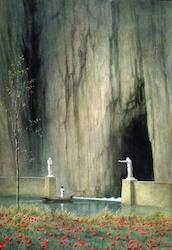Western society has a rather specific view of what a good childhood should be like; protecting, sheltering and legislating to ensure compliance with it. However, perceptions of childhood vary greatly with geography, culture and time. What was it like to be a child in prehistoric times, for example – in the absence of toys, tablets and television?
In our new paper, published in Scientific Reports, we outline the discovery of children’s footprints in Ethiopia which show how children spent their time 700,000 years ago.
...
... the footprints described in our recent study – from a remarkable site in the Upper Awash Valley of Southern Ethiopia ... reveal a bit more. The children’s tracks were probably made by the extinct species Homo heidelbergensis (600,000 to 200,000 years ago), occurring next to adult prints and an abundance of animal tracks congregated around a small, muddy pool. Stone tools and the butchered remains of a hippo were also found at the site, called Melka Kunture.
... The tracks ... may have been made by children as young as one or two, standing in the mud while their parents and older siblings got on with their activities. This included knapping the stone tools with which they butchered the carcass of the hippo.
The findings create a unique and momentary insight into the world of a child long ago. They clearly were not left at home with a babysitter when the parents were hunting. In the harsh savannah plains of the East African Rift Valley, it was natural to bring your children to such daily tasks, perhaps so they could observe and learn.
This is not surprising, when one considers the wealth of ethnographic evidence from modern, culturally distinct human societies. Babies and children are most often seen as the lowliest members of their social and family groups. They are often expected to contribute to activities that support the mother, and the wider family group, according to their abilities. In many societies, small boys tend to help with herding, while young girls are preferred as babysitters. Interestingly, adult tools – like axes, knives, machetes, even guns – are often freely available to children as a way of learning.
So, if we picture the scene at Melka Kunture, the children observing the butchery were probably allowed to handle stone tools and practice their skills on discarded pieces of carcass while staying out of the way of the fully-occupied adults. This was their school room, and the curriculum was the acquisition of survival skills. There was little time or space to simply be a child, in the sense that we would recognise today.
This was likely the case for a very long time. The Monte Hermoso Human Footprint Site in Argentina (roughly 7,000-years-old) contains predominantly small tracks (of children and women) preserved in coastal sediments and it has been suggested that the children may have played an important role in gathering seafood or coastal resources. ...
...
... the overwhelming parenting lesson from the distant past is that children had more responsibilities, less adult supervision and certainly no indulgence from their parents. It is a picture of a childhood very different from our own, at least from the privileged perspective of life in Western society.
Hey kids! Go skin that hippo, will ya?
-
de officiis

- Posts: 2528
- Joined: Wed Nov 30, 2016 11:09 am
Hey kids! Go skin that hippo, will ya?
What ancient footprints can tell us about what it was like to be a child in prehistoric times
